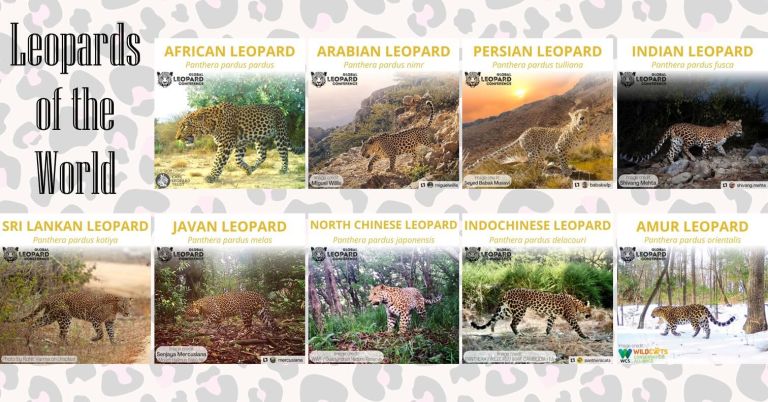The leopard is one of the most charismatic animals on the planet. May 3rd is dedicated to celebrating these majestic felines, and to creating awareness about the plight of leopards worldwide. Let’s take a closer look at these spotted cats as we celebrate International Leopard Day.
The scientific name for leopards is Panthera pardus. Along with lions, jaguars, tigers and snow leopards, they form the so-called ‘big cats’ in the Panthera genus. Leopards are the most versatile and adaptable of this group, both in terms of the habitat where they can survive and the prey animals they hunt. They occur in lush forests, open savanna, rocky deserts, rugged mountains and dense bushveld. Diet studies have shown that leopards worldwide consume more than 100 prey species – from rats and mice to ungulates as large as a young eland. They are the ultimate opportunists and will even eat insects like beetles and crickets when times are tough – there is even a very successful population of leopards in India that prey mainly on feral dogs. In general though, leopards prefer medium-sized prey around 10-40kg (depending on the area).
Despite this adaptability, the situation is not looking promising for leopards. They have already lost a significant 75% of their historical distribution, mainly due to habitat destruction. Where they still occur, their distribution range is increasingly fragmented by continued development. Other main threats include the depletion of their prey base, direct conflict with people, unsustainable trophy hunting and poaching for body parts and skins. Leopards are classified as Vulnerable by the International Union for Conservation of Nature (IUCN) Red List of Threatened Species, and the population trend is decreasing.
Modern leopards occur in Africa and Asia – they have always been absent from the Americas, Antarctica and Australia. In total, leopards occur in 63 countries, but this is only a fraction of the area they once roamed. Not all leopards in the world are the same though. There is significant variation within the species – enough to separate one group from another (mainly based on genetic differences, but also differences in size, colour and pattern). We recognise various distinct groups based on where exactly they occur, and we call these ‘sub-species’. These all still belong to the same species – Panthera pardus – but each group also has a third name added to denote which sub-species they belong to.
Currently, 9 sub-species of leopards are recognised by the IUCN. All leopards in Africa belong to the same group, and this is also the oldest of all the sub-species. Then there is the Arabian, Indian, Persian, Sri Lankan, Amur, Javan, Indo-Chinese and North Chinese leopard (although the validity of the latter as a separate sub-species is tenuous, and it will likely be included under the Amur sub-species in the next IUCN re-assessment.). Incidentally the ‘snow leopard’ is not a kind of leopard, but a completely separate species on its own – Panthera uncia – and so is the clouded leopard, Neofelis nebulosa.
Leopards are of immeasurable ecological value and we use a number of different terms to denote the ways they are important:
- Leopards are apex predators that play a vital role in maintaining the functioning and diversity of ecosystems. The presence of top carnivores like the leopard regulates herbivore numbers through predation, and the numbers of smaller medium-sized carnivores through competition and dominance.
- The leopard is an umbrella species for wider biodiversity conservation. Conservation efforts focused on the continued survival of leopard populations (which include preserving their habitat and prey species) also benefit other species and ecosystem processes.
- The leopard is a flagship species for conservation and environmental education. Leopards are well-known, charismatic and iconic, and can be used to promote awareness and rally support for prey and habitat conservation.
- The leopard is a keystone species that plays a crucial role in maintaining the structure of their ecological communities. Leopards have a major effect on the health of environments. Without them, the ecosystem where they occur would be dramatically different or cease to function altogether.
Research and conservation actions aimed at protecting leopard habitat and prey, and minimising the other threats to their survival are thus of utmost importance. Please consider supporting organisations that are dedicated to understanding and protecting leopards in their local context – the Cape Leopard Trust is a fantastic example!
Background to International Leopard Day:
March 2023 marked the inaugural Global Leopard Conference (GLC), which brought together hundreds of researchers, students, conservationists and enthusiasts in the first-ever international gathering dedicated to leopards. The GLC was a hugely successful and insightful week of sharing, learning, and connecting among researchers and conservationists working across the leopard’s range. As a lasting legacy of the GLC, International Leopard Day on 3 May was officialised and endorsed to give it a permanent and meaningful place on the global wildlife calendar, enabling higher awareness, promotion and celebration of leopards worldwide.
Read more at internationalleopardday.org
Author credit: Cape Leopard Trust | Jeannie Hayward

















